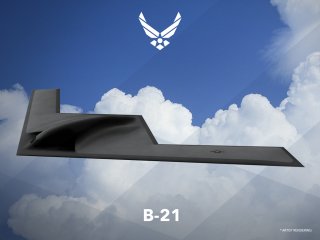B-21 Stealth Bomber Update: Set to Fly Next Year?
The first serial B-21s are expected to begin operations in the mid-2020s. The current target is to have at least one hundred of the B-21 Raiders in service by the early 2030s to replace the aging fleet of Air Force bombers.
It has been a busy month for Air Force Gen. Timothy Ray, the head of the U.S. Air Force Global Strike Command. He took part in a very special tour, one that involved seeing the progress that is being made on the Northrop Grumman B-21 Raider. The aircraft’s first flight could still be a year away, but Gen. Ray made the rounds to check in to make sure that is still on track.
The B-21 is a heavy stealth strategic bomber with its roots in the Long Range Strike Bomber program (LRS-B), an early to mid-2010s procurement program for a long-range, nuclear-capable strike bomber.
It is routine for Air Force leaders to want to check in on the progress, and in February 2020, Air Force senior leaders met with industry partners at Northrop Grumman’s Melbourne, Florida, B-21 Raider design and development headquarters.
Air Force Magazine cited the Rapid Capabilities Office (RCO), which manages the B-21 program, and reported that Ray was able to see the “significant progress made on the build of the first flight test aircraft that will one day make its way to Edwards Air Force Base, [California], for testing.”
RCO has said that flight testing of the B-21 Raider test aircraft No. 1 will begin as soon as it is completed, and that is expected to be sometime next year. The first flight will be preceded by outside engine runs and taxi tests of increasing speed.
Ray began his bomber test tour on May 5 when he visited the 419th Flight Test Squadron, Global Power Combined Test Force, the unit that performs tests on the U.S. Air Forces current fleet of B-1 Lancer, B-2 Spirit and B-52 Stratofortress bombers, according to Air Force Magazine. It is the 419th Flight Test Squadron that is currently performing tests on the AGM-183A Air-launched Rapid Response Weapon, a hypersonic missile that will be equipped on the B-52 and B-1 as well as the F-15 Strike Eagle.
The tour also included a visit to the B-21 Combined Test Force comprising the 420th Flight Test Squadron and Detachment Five of the Air Force Operational Test and Evaluation Center, as well as to Northrop Grumman, which is the prime contractor on the Raider. That included a visit to the defense contractor’s Plant 42 facility in Palmdale, California, where the B-21 Raider will undergo final assembly.
Earlier this month, Breaking Defense reported reported that the B-21 bomber—which will eventually replace the B-1, B-2 and B-52 bombers—will have as much in common with those Cold War-era aircraft as the Lockheed Martin F-35 Lightning II has in common with its World War II-era predecessor P-38 Lightning. The B-21 Raider’s designers have been able to take advantage of digital capabilities to improve the design, manufacturing and support.
“The digital trinity of digital engineering and management, agile software, and open architecture, is the true successor to stealth. It’s the next big paradigm shift for military tech dominance,” Will Roper, the recently departed assistant secretary of the Air Force for Acquisition, Technology and Logistics, said in his October 2020 report There is No Spoon: The New Digital Acquisition Reality.
Ray has said that the first serial B-21s are expected to begin operations in the mid-2020s. The current target is to have at least one hundred of the Raiders in service by the early 2030s to replace the aging fleet of Air Force bombers.
Peter Suciu is a Michigan-based writer who has contributed to more than four dozen magazines, newspapers and websites. He regularly writes about military small arms, and is the author of several books on military headgear including A Gallery of Military Headdress, which is available on Amazon.com.
Image: Reuters

